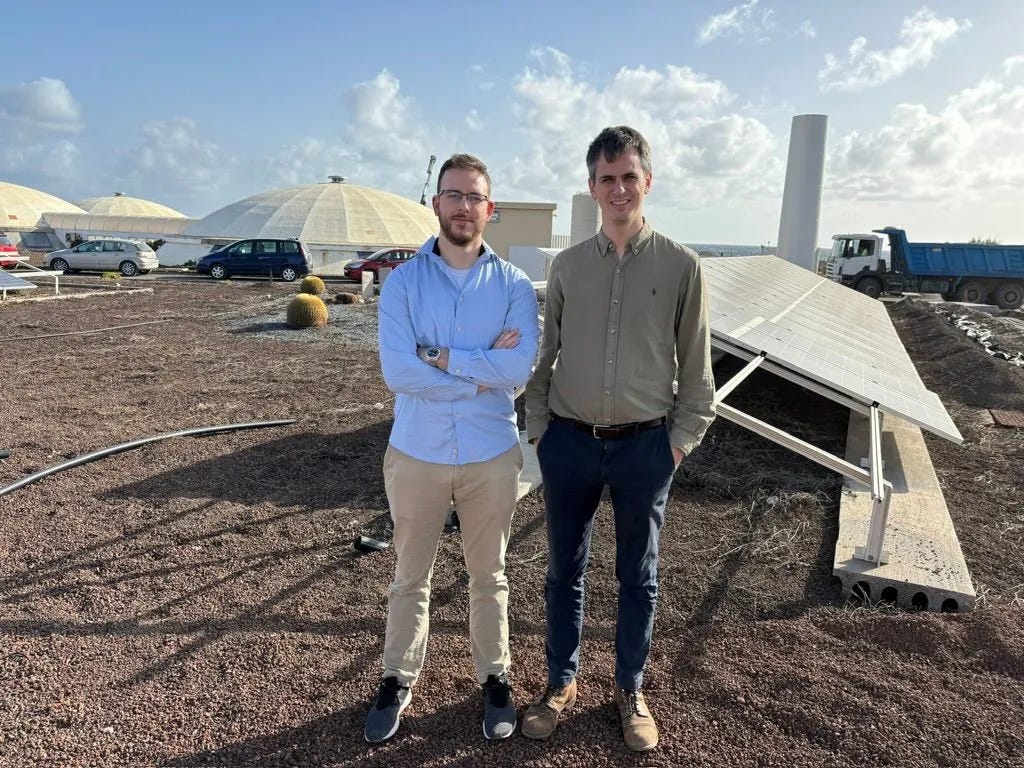From sea to sky: Brineworks' vision of Sustainable Aviation Fuel from seawater
The Dutch startup's innovative CO2 extraction method aims to reduce costs to below $100 per tonne, potentially overcoming a key bottleneck in e-fuel production.
The aviation industry faces a unique hurdle in reducing its carbon footprint. While electric and hydrogen-powered aircraft are being actively developed, current technological limitations mean that jet fuel will, in the medium term, remain the primary power source for long-distance flights. This reality necessitates finding alternative ways to decarbonise the industry.
Two approaches are receiving increased focus in these decarbonisation efforts:
Sustainable Aviation Fuels (SAF): These cleaner alternatives to traditional jet fuel are made from non-fossil-fuel feedstocks. The newest generation of SAF, called e-fuels or Power-to-Liquid (PtL) fuels, require a reliable and affordable source of carbon dioxide (CO2) and green hydrogen made from renewable energy.
Carbon Dioxide Removal (CDR): As traditional carbon offsetting has become increasingly problematic and criticised for its effectiveness, the industry is turning to more direct methods of removing CO2 from the atmosphere.
Both these approaches face a common challenge: capturing or sourcing CO2 efficiently and cost-effectively.
Now, a Dutch startup called Brineworks has developed a novel solution to this challenge — the ability to harness CO2 from the oceans to produce aviation fuel using nothing more than seawater and renewable energy.
This concept offers a tantalising prospect: sustainable aviation fuel could be produced anywhere there's a coastline and renewable energy. Brineworks' approach could potentially address many SAF production and CDR challenges simultaneously.
The Brineworks solution
Brineworks is developing a method to extract CO2 from seawater, which could potentially provide the large quantities of CO2 needed for sustainable fuel production at a considerably lower cost than current carbon capture methods.
Gudfinnur Sveinsson, CEO of Brineworks, explained the technology to Sustainability in the Air:
"We're building a very novel technology to extract CO2 and hydrogen from seawater. With those outputs, you can make e-fuels for both the aviation and maritime sectors."
The core of Brineworks' innovation is a seawater electrolyser that powers a Direct Ocean Capture (DOC) system. The process works as follows:
Seawater is input into the system;
The seawater electrolyser splits part of the seawater into acid and base streams:
The acid is used to lower the pH of the seawater, causing CO2 to be released as a gas;
The base stream is then used to neutralise the pH, completing the pH swing system.
This method leverages the ocean's vast capacity to absorb atmospheric CO2, which accounts for a significant portion of human-caused emissions.
Scalability and advantages
One key advantage of Brineworks' ocean-based CO2 extraction technology is its potential for scalability, especially compared to current biogenic sources used by many e-fuel companies for their CO2 feedstocks.
While these biogenic sources, like ethanol plants, fermentation processes, and biomass combustion, can be cost-effective in the short term, they face significant scalability challenges:
Biogenic sources are often limited in availability, localised, and subject to land use concerns and seasonal variability.
They may also compete with food production or lead to deforestation, raising sustainability issues.
Additionally, these sources are often not co-located with ideal renewable energy sites, increasing logistical complexity and costs.
In contrast, Brineworks' approach offers several scalability advantages:
Vast resource: Oceans cover 71% of Earth's surface and contain about 50 times more CO2 than the atmosphere, providing an enormous, globally distributed carbon source.
Consistent supply: Ocean CO2 concentrations are relatively stable, ensuring a reliable, year-round supply for e-fuel production.
Flexible siting: Ocean-based extraction can be located near renewable energy sources and e-fuel production facilities, reducing transportation costs and emissions.
Minimal land use: Unlike biogenic sources, ocean-based extraction doesn't compete for land use with agriculture or natural habitats.
Potential for continuous improvement: As an emerging technology, ocean-based extraction has significant room for efficiency improvements and cost reductions as it scales.
Sveinsson emphasises the long-term sustainability of the company’s approach:
"For a global scale of e-fuels, we cannot rely on biogenic or biomass CO2 sources because it would get harder and harder to source this biomass to get the CO2 responsibly, and the price will go up."
One of the most significant potential impacts of Brineworks' technology is its cost-effectiveness. A report from ETH Zurich earlier this year estimated that current direct air capture (DAC) methods could eventually cost anywhere from $230 to $835 per tonne of CO2, far above the $100 per tonne barrier often cited as necessary for economic viability.
Sveinsson is confident about Brineworks' potential to break this barrier:
"We see that with the latest version of our electrolyser, we could support CO2 extraction out of the ocean for less than $100 per tonne."
This cost-effectiveness could be crucial for e-fuel production in the aviation industry, while also potentially contributing to carbon management efforts (see the section on comparison with other technologies).
Industry initiatives and Brineworks' funding
While innovative technologies like Brineworks' are still in development, major airlines are already taking steps towards carbon removal.
In September 2024, British Airways signed a significant carbon removal agreement worth over £9 million, covering carbon removal credits over a six-year period. The initiative includes partnerships with various carbon removal projects, including DAC with Climeworks in Iceland, enhanced rock weathering across the UK, reforestation projects in Scotland and Wales, and innovative capture methods such as CO2 capture from whisky distilleries in Scotland.
This makes British Airways the largest airline purchaser of carbon removals, marking a significant step forward as the aviation sector embraces the growing importance of carbon removal technologies.
However, it also highlights the current limitations: the amount of CO2 removed is still tiny compared to the industry's total emissions, and current technologies, especially DAC, are expensive and energy-intensive.
In this context, Brineworks' ocean-based CO2 extraction method could offer significant advantages, including potentially lower costs than current DAC methods, scalability to meet more significant portions of the industry's carbon removal needs, and integration with e-fuel production.
This potential has not gone unnoticed by investors. In June 2023, the company secured $2.2 million in pre-seed funding, led by Nordic VC firm Pale Blue Dot, with participation from First Momentum Ventures and Nucleus Capital. This investment underscores the perceived promise of Brineworks' approach and will help accelerate the company's technical development and support the deployment of its first technical pilot project.
Current status and future plans
Brineworks, despite being founded just over a year ago, has made significant progress. It has already built and extensively tested its novel electrolyser with actual seawater and brine streams and has a test facility in Gran Canaria, Canary Islands.
The next step is a pilot plant planned for next year, which will start extracting CO2 from seawater. While the location is yet to be confirmed, the company is evaluating several options in different countries.
Looking ahead, Brineworks aims to roll out its electrolyser technology and DOC process globally over the next 10-15 years.
The scale and impact of their operations will largely depend on regulatory frameworks around point source capture and sustainability criteria for e-fuels in the aviation and maritime sectors. As Sveinsson notes,
"I think that will dictate in large parts how quickly we will scale up e-fuels. The technology is there or is getting there."
Comparison with other technologies
Brineworks' approach shares some similarities with other seawater-based technologies, such as those developed by Equatic, which has an offtake agreement with Boeing. However, it differs in its focus on extracting CO2 directly as a gas from the ocean.
While Sveinsson focused more on CO2 extraction in his conversations with us, the company's lead investor, Pale Blue Dot, highlights the dual output of CO2 and green hydrogen as an additional advantage.
In a blog post, Pale Blue Dot states:
"Not only does their system extract CO2 from seawater, but it also co-produces significant amounts of green H2 so they can provide both of the feedstocks needed for e-fuels. That makes their product uniquely ready to offer fuel independence to ships, planes, and even seaports. All they need is water and salt.”
This suggests that hydrogen production could be another benefit for potential customers, particularly in the context of e-fuel production.
Finally, it's important to understand the role of Brineworks' DOC technology in the broader context of carbon management strategies.
Unlike DAC, which pulls CO2 directly from the atmosphere, DOC technologies like Brineworks extract CO2 from seawater. This is generally considered more energy-efficient due to the higher concentration of CO2 in seawater compared to air.
By extracting CO2 from seawater, DOC technologies could potentially create a concentration gradient that leads to more CO2 being absorbed from the atmosphere into the ocean. However, this is a complex process influenced by many factors, including ocean currents, temperature, and biological activity.
As a result, Brineworks’ technology offers a vital CO2 source for e-fuel production, supporting the aviation industry’s shift to sustainable fuels and carbon management solutions.
Our take
Brineworks' technology represents a promising development in the quest for sustainable aviation. By potentially providing both cost-effective carbon extraction and crucial feedstocks for e-fuel production, it could play a big role in the industry's transition to net-zero emissions.
As Pale Blue Dot says in its blog post, "What if any nation in the world could make sustainable oil from seawater?"
Ultimately, they are holding out a vision where they will “empower fuel producers for airlines and seaports to extract CO2 and H2 directly from the sea, delivering an abundant and inexpensive source of e-fuel feedstock”.
This vision of a world where clean aviation fuel can be produced anywhere there's a coastline and renewable energy is compelling, and is what prompted Pale Blue Dot and its partners to invest.
Yet, as with any early-stage technology, the real-world effectiveness and scalability of Brineworks’ approach remain to be proven. The coming years will be crucial in determining whether Brineworks can deliver on its promising potential and contribute significantly to the decarbonisation of the aviation and maritime sectors.
While the company is confident in its technology, it will take further funding and bankable offtake agreements to help it scale and turn that vision into commercial-scale reality.
Glossary of terms
Sustainable Aviation Fuel (SAF) - Cleaner alternatives to traditional jet fuel, made from non-fossil-fuel feedstocks. SAFs can significantly reduce carbon emissions compared to conventional jet fuel.
E-Fuels - Also known as electrofuels or synthetic fuels, these are a type of SAF produced by combining CO2 with hydrogen. The hydrogen is typically produced through electrolysis powered by renewable energy.
Power to Liquid (PtL) Fuels - Another term for e-fuels, emphasising the use of electrical power in the production process.
Carbon Dioxide Removal (CDR) - The process of removing carbon dioxide from the atmosphere.
Direct Air Capture (DAC) - A technology that captures CO2 directly from the ambient air.
Direct Ocean Capture (DOC) - A method that chemically removes CO2 from seawater.
Seawater Electrolyser - A device that uses electricity to split seawater into different components, in this case, to facilitate CO2 extraction and potentially produce hydrogen.
pH Swing System - A method used in Direct Ocean Capture to alter the pH of seawater, causing CO2 to be released and then captured.
Biogenic CO2 Sources - Sources of CO2 that come from biological processes, such as fermentation or biomass combustion.
Green Hydrogen - Hydrogen produced through electrolysis powered by renewable energy sources.
Carbon Offsetting - The practice of compensating for carbon emissions by funding an equivalent carbon dioxide saving elsewhere.
Enhanced Rock Weathering - A carbon removal technique that accelerates the natural process of rock weathering to absorb CO2 from the atmosphere.
For October 2024, we’re pleased to feature SITA as our exclusive Sponsor of the Month. SITA is a global IT provider for the air transport industry, helping airlines navigate complex environmental regulations. Discover how their Eco Mission tool can simplify compliance, reduce costs, and provide real-time insights to support your sustainability goals.







